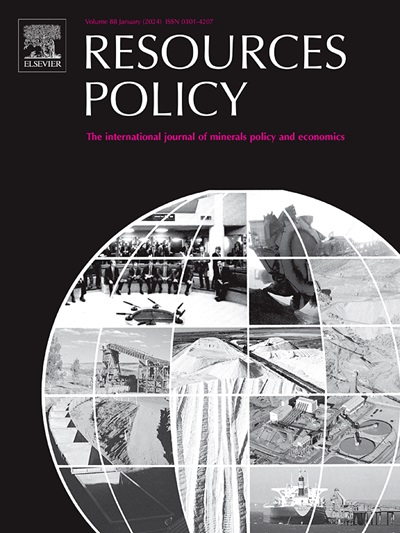Recovery of strategic elements from mining tailings at La Cienega, Peru, through geochemical and mineralogical assessment: a focus on circular economy policy
IF 10.2
2区 经济学
0 ENVIRONMENTAL STUDIES
引用次数: 0
Abstract
Amid growing global concern over the security and sustainability of critical raw material supply, mine tailings deposits are increasingly being reconsidered as strategic secondary resources. This study evaluates the revalorization potential of Tailings Deposit I at La Cienega (northern Peru) through a comprehensive methodology that integrates geochemical and mineralogical characterization with geostatistical modeling, in support of circular economy frameworks and resource governance. A total of 68 samples from drill cores and trenches were analyzed, focusing on strategic elements such as silver (Ag), lead (Pb), molybdenum (Mo), copper (Cu), antimony (Sb), zinc (Zn), cadmium (Cd), scandium (Sc), and indium (In). Average concentrations were found to be 2293.60 ppm for Pb, 719.61 ppm for Zn, and 98.65 ppm for Cu, along with spatially structured trace levels of In (0.14 ppm) and Sc (9.00 ppm). Ordinary kriging modeling yielded high correlation coefficients (R > 0.8) for Cu, Cd, and Sc, enabling robust three-dimensional estimation of recoverable resources. Mineralogical analysis identified dominant phases such as pyrite and arsenopyrite, along with secondary minerals like jarosite, which influence metal availability. The results underscore the dual character of the deposit as both an environmental liability and a latent strategic asset. Within the context of Peru's evolving institutional and regulatory framework including the MINEM–INGEMMET agreements and the roadmap toward a circular economy in mining this study provides key technical evidence to support sustainable reindustrialization policies. The selective recovery of critical metals and mitigation of toxic elements position the La Cienega deposit as a replicable case of circular mining and integrated resource governance.
通过地球化学和矿物学评估从秘鲁La Cienega的采矿尾矿中回收战略元素:重点是循环经济政策
在全球对关键原料供应的安全性和可持续性日益关注的背景下,矿山尾矿库越来越被重新视为战略二次资源。为了支持循环经济框架和资源治理,本研究通过将地球化学和矿物学特征与地质统计建模相结合的综合方法,评估了La Cienega(秘鲁北部)1号尾矿库的再估值潜力。共分析了68个岩心和沟槽样品,重点分析了银(Ag)、铅(Pb)、钼(Mo)、铜(Cu)、锑(Sb)、锌(Zn)、镉(Cd)、钪(Sc)和铟(In)等战略元素。铅、锌和铜的平均浓度分别为2293.60 ppm、719.61 ppm和98.65 ppm,微量In (0.14 ppm)和Sc (9.00 ppm)呈空间结构分布。普通克里格模型为Cu、Cd和Sc提供了高相关系数(R > 0.8),从而实现了对可采资源的可靠三维估计。矿物学分析确定了优势相,如黄铁矿和毒砂,以及影响金属可用性的次生矿物,如黄钾铁矾。研究结果强调了该矿床作为环境负债和潜在战略资产的双重特征。在秘鲁不断发展的制度和监管框架(包括MINEM-INGEMMET协议和矿业循环经济路线图)的背景下,本研究为支持可持续的再工业化政策提供了关键的技术证据。关键金属的选择性回收和有毒元素的减少使La Cienega矿床成为循环采矿和综合资源治理的可复制案例。
本文章由计算机程序翻译,如有差异,请以英文原文为准。
求助全文
约1分钟内获得全文
求助全文
来源期刊

Resources Policy
ENVIRONMENTAL STUDIES-
CiteScore
13.40
自引率
23.50%
发文量
602
审稿时长
69 days
期刊介绍:
Resources Policy is an international journal focused on the economics and policy aspects of mineral and fossil fuel extraction, production, and utilization. It targets individuals in academia, government, and industry. The journal seeks original research submissions analyzing public policy, economics, social science, geography, and finance in the fields of mining, non-fuel minerals, energy minerals, fossil fuels, and metals. Mineral economics topics covered include mineral market analysis, price analysis, project evaluation, mining and sustainable development, mineral resource rents, resource curse, mineral wealth and corruption, mineral taxation and regulation, strategic minerals and their supply, and the impact of mineral development on local communities and indigenous populations. The journal specifically excludes papers with agriculture, forestry, or fisheries as their primary focus.
 求助内容:
求助内容: 应助结果提醒方式:
应助结果提醒方式:


